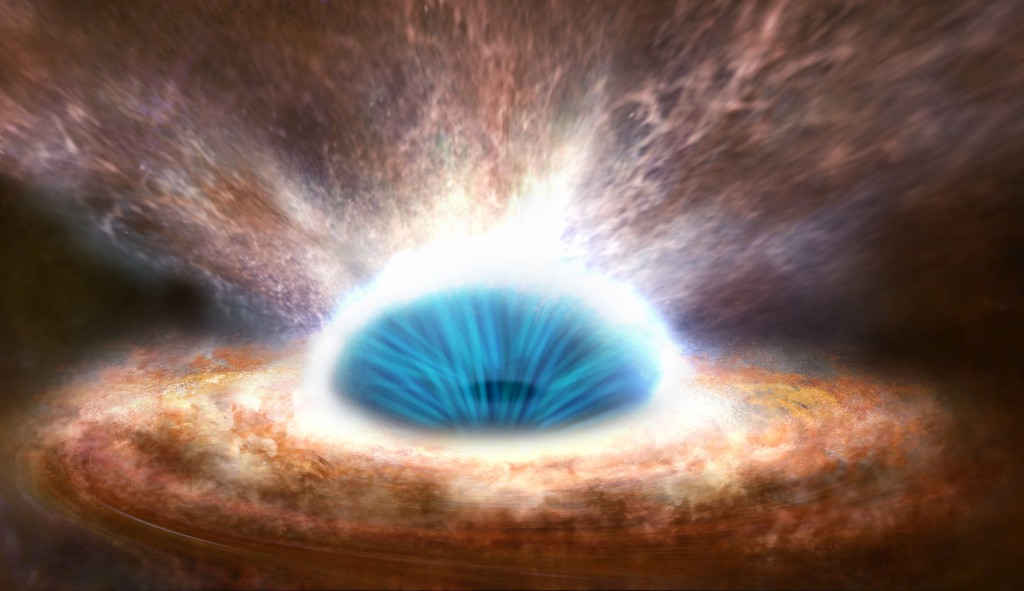The three galaxies unite to
The supermassive black hole is 4 billion times the size of the Sun when three spiral galaxies collide, leading to the merging of black holes in their center .

The supermassive black hole is 3.8 billion times larger than the Sun at the center of IRAS 20100-4156.(Artwork: UMG).
According to Tech Insider, Australian Square Kilometer Array Pathfinder (ASKAP) researchers discovered a special black hole when conducting routine measurements. Gas streams in the center of a galaxy 1.8 billion light-years from Earth move at a speed of more than 600 km / h, twice as fast as the team predicted.
The super-fast movement speed of the air stream indicates the existence of an unusual object, a giant black hole at the center of the galaxy. Scientists believe that at the center of every large galaxy there exists a supermassive black hole . Our Milky Way is the home of a black hole 4 million times more massive than the Sun.
The IRAS 20100–4156 galaxy , however, observed by the team at ASKAP seems to include three separate spiral galaxies (a type of galaxy forming a star disk, dust and gas rotating on a flat surface, somewhat center bulges due to high density of star density. When these galaxies hit each other, the black hole in their center merged into one, forming a massive black hole 3.8 billion times heavier than the Sun.
The gas formed near the galactic center rotates due to the extreme gravity of the black hole and emits radio waves, recorded by two ASKAP telescopes and Australia Telescope Compact Array. The research team announced the discovery on April 26 in the monthly journal of the Royal Astronomical Society.
"This fast-moving gas stream tells us about the magnitude of the black hole. This is a direct way to measure the mass of black holes with an object around it, a really interesting method , " says astrophysicist. Lisa Harvey-Smith, the lead author of the study, shared.
The supermassive black hole is located in the area where dust and stars are produced in the center of the galaxy, with an unusually fast rate of star formation. Although the black hole destroys everything around them, scientists observe that a black hole originating from a merged galaxy can lie next to star-producing regions at a rate 100 times faster than other areas of the universe. .
According to the team, accelerated star formation may be due to star clouds being compressed when colliding in the process of a galaxy merging."We want to know whether intergalactic collisions and super-massive black hole formation affect the rate at which stars form and how that effect changes over time, " said Harvey-Smith. .
Physicists believe that the largest black hole in the universe could reach 40 billion times the mass of the Sun. According to Harvey-Smith, measuring the mass of black holes in galaxies of different ages can help researchers better understand how galaxies evolve in cosmic history.
- The mystery of the dead galaxies
- Detecting a group of 'ghost galaxies'
- Discover 'living fossil' galaxies in the universe
- Discover the birth of ancient galaxies
- The Milky Way is lighter than we thought
- Stunned disclosure of technology to identify cosmic galaxies
- Clash between two galaxies
- Close up of galactic conflict
- The galaxy eats each other to grow
- Stars don't form when big galaxies collide
- What is the motion map of 1400 galaxies?
- What is the Milky Way? What are the different galaxies and galaxies?
 Van Allen's belt and evidence that the Apollo 11 mission to the Moon was myth
Van Allen's belt and evidence that the Apollo 11 mission to the Moon was myth The levels of civilization in the universe (Kardashev scale)
The levels of civilization in the universe (Kardashev scale) Today Mars, the sun and the Earth are aligned
Today Mars, the sun and the Earth are aligned The Amazon owner announced a secret plan to build a space base for thousands of people
The Amazon owner announced a secret plan to build a space base for thousands of people